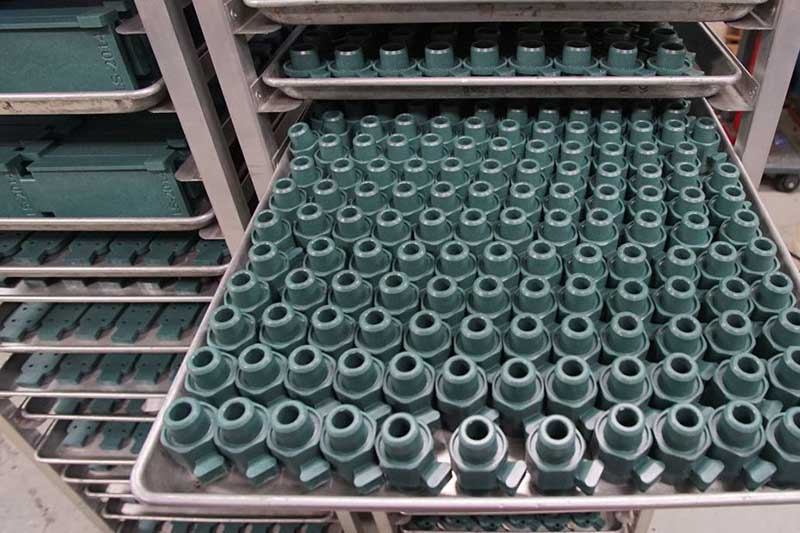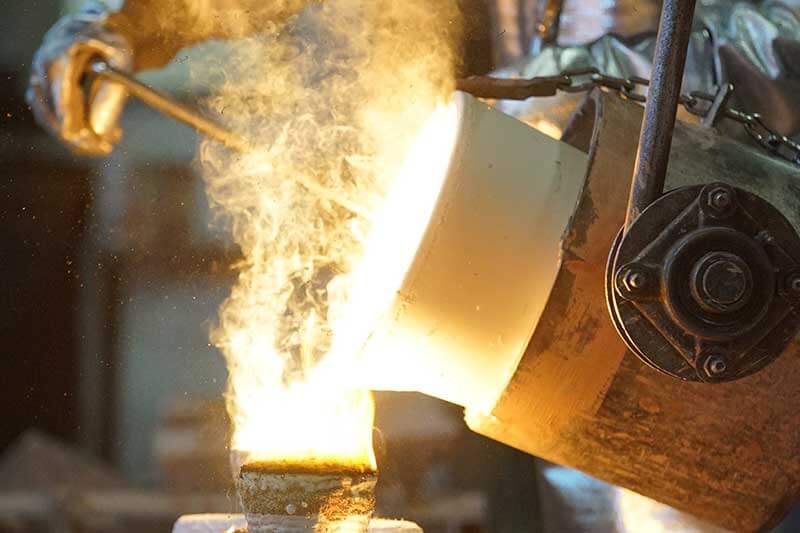Casting stainless steel is a highly specialized process that forms the backbone of advanced manufacturing, enabling the production of components with exceptional mechanical properties and corrosion resistance. Through the investment casting process, stainless steel, in its molten state, is meticulously poured into precision molds, giving birth to complex geometries and designs.
The Investment Casting Process
Investment casting is a manufacturing process where a disposable pattern, either wax or plastic, is coated with a refractory ceramic material. Once the ceramic is applied in multiple layers and allowed to dry, it forms a thin shell mold after the pattern is melted or burned out, suitable for pouring the molten metal into.
The Role of Wax Patterns
Creation of Wax Patterns
Wax patterns are essential in investment casting as they define the shape of the final product. Additionally, the wax is inexpensive and can be melted out of the mold at a low temperature using steam.
Benefits of Wax Patterns in Investment Casting
Using wax patterns allows for high dimensional accuracy and intricate details in the final casting.

The Ceramic Shell and Mold
Formation of Ceramic Shell
The wax patterns are clustered and attached to a feed sprue, custom engineered and made from recycled wax, and this “tree” is repeatedly dipped into a ceramic slurry to form a ceramic shell, which becomes the mold.
Pouring of Molten Stainless Steel
Molten stainless steel is poured into the ceramic mold and allowed to solidify.
Achieving Desired Shape and Custom Parts
Investment casting allows for producing parts in almost any desired shape, providing the flexibility to create custom parts. Due to the relatively high cost of making components in stainless steel, investment casting to “near net shape” saves on the amount of material that needs to be removed to meet the finished dimensions of the component. This process is not only cost-effective but also ensures material efficiency.
Finishing Processes
Machining and Surface Finishing
After casting, the components often require additional machining to meet tight tolerances and achieve the desired dimensions. Stainless steel investment castings can be easily machined due to the material’s properties. Additionally, various surface finishing processes are employed to enhance the properties and appearance of the cast stainless steel components. These finishing processes include passivation for optimum corrosion resistance, electro-plating, electro-polishing, or hard polishing. Mechanical polishing is particularly effective in providing a mirror finish, often desired for aesthetic or cleanliness purposes.
Heat Treatment
Heat treatment is used to enhance the mechanical properties of certain grades of stainless steel, as well as enhance the corrosion resistance of the casting in other grades.
Rapid Prototyping
Rapid prototyping using 3D technologies enables the fast production of patterns made from plastic. These patterns are also disposable and can be used in place of wax patterns for short runs, samples, or to avoid having to build wax injection tooling for special situations.
Types of Stainless Steels Used in Casting
Stainless steel alloys are primarily chosen for casting due to their corrosion resistance and mechanical properties. Additionally, all stainless steels offer outstanding foundry characteristics, including ease of melting in air melt furnaces, excellent fluidity for mold fill, and excellent weldability. The most common categories of cast stainless steel are austenitic, martensitic, duplex, precipitation hardening, ferritic, and super-austenitic alloys, which refer to the micro-structure of the alloy.

Austenitic Stainless Steel
Austenitic stainless steels are either completely non-magnetic or semi-magnetic stainless steels that contain high levels of chromium and nickel, with some containing molybdenum, nitrogen, or stabilizing elements such as columbium.
Martensitic Stainless Steel
Martensitic stainless steels contain primarily chromium and are known for their ability to be heat treated for higher hardness and strength.
Duplex, Precipitation Hardening, Ferritic, and Super-Austenitic Alloys
These stainless steels are generally considered to be specialty alloys and offer various properties, including enhanced corrosion resistance and strength, along with the ability to be age hardened at low temperatures, ideal for machined components to avoid damage during the heat treatment process.
Common Material Grades and Their Applications
Different grades of stainless steel are used for specific applications based on their properties.
Mechanical Properties and Corrosion Resistance
Mechanical Properties of Cast Stainless Steel
Abrasion Resistance
Cast martensitic stainless steels are known for their high abrasion resistance thanks to their ability to be hardened to high Rockwell hardness levels.
Strength and Durability
The mechanical strength and durability of the many grades of stainless steel make it suitable for various applications.
Corrosion Resistance
Types of Corrosion Resistance
Stainless steel offers superior corrosion resistance, protecting against various forms of corrosion.
Stress Corrosion and Cracking
Understanding the causes of stress corrosion cracking is essential for selecting the appropriate stainless steel alloy.
Heat Treatment for Enhancing Properties
Heat treatment processes enhance the mechanical properties and corrosion resistance of stainless steel. Specifically, austenitic, ferritic, and super-austenitic stainless steel castings are provided in a solution-annealed condition. This high-temperature heat treatment gives the casting the highest level of corrosion resistance possible. Only martensitic and precipitation-hardening stainless steels can be made to be harder after casting through heat treatment, while all other stainless steels do not have controllable hardness levels.
Applications and Industries
Fluid Handling Pumps and Valves
Valve Components (Valve Disc, Valve Body)
Valve components made from cast stainless steel are essential in controlling fluid flow.
Pump Components (Pump Bodies and Impellers)
Stainless steel pump components are crucial in ensuring the efficient movement of fluids.
Food and Beverage Processing Equipment
Stainless steel is widely used in food and beverage processing equipment due to its hygienic properties and corrosion resistance.
Marine Components and Stainless Steel Marine Castings
Marine environments require materials that can withstand saltwater corrosion, making stainless steel an ideal choice for marine components.
Medical Industry (Surgical Tools and Operating Room Equipment)
Stainless steel’s ability to be sterilized without compromising its strength or durability makes it essential in medical applications such as surgical tools and operating room equipment.
Construction Industries
In construction, stainless steel is used for its strength, durability, and resistance to weather conditions.
High-Temperature Applications (Turbine Engines, Petrochemical Applications)
Stainless steel’s ability to withstand high temperatures without losing its mechanical properties makes it suitable for applications like turbine engines and petrochemical processing.
The Advantages of Stainless Steel Investment Castings
Dimensional Precision and Tight Tolerances
Investment casting with stainless steel allows for high dimensional precision and tight tolerances, which are essential for specialized components.
Corrosion and Heat Resistance
Stainless steel investment castings offer excellent corrosion and heat resistance, making them suitable for harsh environments.
Customization and Flexibility in Design
Investment casting allows for the customization of parts, providing flexibility in design to meet specific requirements.
Cost-Effectiveness and Material Efficiency
Investment casting is a cost-effective method that minimizes material wastage, especially when using expensive materials like stainless steel.
Niagara Investment Castings’ Expertise

Comprehensive Services and Capabilities
Niagara Investment Castings offers a diverse array of services to meet the multifaceted needs of its clients. These services include:
- Machining: Precision machining services to achieve the final dimensions and surface finish of the cast components.
- Heat Treatment: A range of heat treatment options to enhance the mechanical strength and corrosion resistance of the metal alloys.
- Material Testing and Certification: Rigorous material testing and certification processes to ensure the quality and compliance of the cast products.
- Rapid Prototyping: Utilizing advanced 3D technologies for fast production of sample castings, allowing clients to test and validate designs before full-scale production.
These services are integral to delivering high-quality stainless steel castings tailored to various industries’ specific requirements.
Commitment to Quality and Certification
The company is committed to delivering high-quality products and has a rigorous material testing and certification process.
Client Collaboration and Support
Niagara Investment Castings emphasizes client collaboration to ensure the final product meets their specifications and requirements.
Harnessing the Potential of Stainless Steel Casting for Tomorrow’s Innovations
As we have explored throughout this article, the casting of stainless steel is an incredibly versatile and essential process in manufacturing. The diverse range of stainless steel alloys, coupled with the investment casting process, empowers industries to create components with exceptional mechanical properties and corrosion resistance. Niagara Investment Castings stands at the forefront of this field with its comprehensive services, commitment to quality, and collaborative approach with clients.
Looking ahead, the role of stainless steel casting is poised to expand even further. As industries evolve and new challenges emerge, the demand for high-quality, durable, and corrosion-resistant materials will continue to grow. Stainless steel casting will be at the heart of innovations in sectors ranging from healthcare and food processing to renewable energy and aerospace.
Through continuous advancements in technology and a commitment to excellence, companies like Niagara Investment Castings will play a pivotal role in shaping the future, delivering solutions that meet today’s demands and pave the way for tomorrow’s innovations.
For more information on the services and capabilities of Niagara Investment Castings, don’t hesitate to get in touch with us today.
